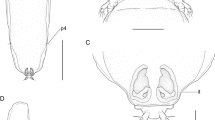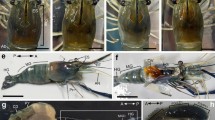Abstract
This study deals with the formation of vitelline envelope (VE) and chorion compartments in several free living and parasitic acaridid mites.
In all investigated mites, the VE is of primary origin (produced by oocyte itself), whereas exochorion material is of tertiary origin (oviduct or chorion gland secretion).
In acarid mites Acarus siro and Tyrophagus perniciosus, VE formation starts with the oviductal oocytes in which vitellogenesis already proceeds. It is characterized by stratification (Acarus) or coarse fibrillar texture (Tyrophagus). Oocyte microvilli penetrating VE material were not observed. When the vitellogenesis terminates, VE becomes homogeneous and is transformed into chorion. This is the only layer protecting the deposited egg in A. siro, whereas in T. perniciosus the chorion-coated eggs passing through the distal portion of the oviduct are additionally covered by exochorion material deposited in three distinct forms: dense patches, granules, and most conspicuous locular chambers. In Tyrophagus longior, the egg surface closely resembles that of T. perniciosus, but the locular chambers are smaller. In Aleuroglyphus ovatus the exochorion material forms tiny spherical patches instead of locular chambers.
In Sarcoptes scabiei, Notoedres cati and Falculifer rostratus, flocculent VE appears on vitellogenic oocytes in the oviduct. VE development is characterized by formation of numerous lenticular perivitelline spaces, which initially grow to disappear later. Then VE material transforms into fully homogeneous chorion. Chorion glands in Sarcoptes and Notoedres produce multivesicular secretory bodies; their content is released onto the egg surface to form a vesicular monolayer (exochorion) during the egg passage. The chorion gland in Falculifer is composed of two secretory cell types. Its secretion possibly glues the eggs to the host feather barb during highly ordered deposition, and forms the appendage ending with a ribbed plate, here considered to be a print of female undulate lamina acting as an ovipositor. The hatching suture is present. Neither distinct micropyle nor aeropyles have been found in eggs of species under study.
The exochorion is proposed to be an adhesive layer which fixes the eggs to the substratum. The same role plays the chorion gland secretion in F. rostratus. It can be argued, however, that locular chambers of Tyrophagus exochorion may participate in reduction of water loss rather than in egg adherence or plastron respiration, as previously suggested in the literature.
Similar content being viewed by others
References
Aeschlimann A., 1958. Développement embryonnaire d'Ornithodoros moubata (Murray) et transmission transovarienne de Borrelia duttoni. Acta Trop., 15: 15–64.
Arthur R.D., 1948. On the egg of the tick, Ixodes ricinus. J. Parasitol., 39: 53–60.
Baker G.T. and Chandrapatya A., 1991. Fine structure of the chorion of the broad mite Polyphagotarsonemus latus (Prostigmata: Tarsonemidae). In: F. Dusbabek & V. Bukva (Editors), Modern Acarology. Academia, Prague and SPB Academic Publishing, Hague, Vol. 2, pp. 325–328.
Baker G.T. and Krantz G.W., 1985. Structure of the male and female reproductive and digestive systems of Rhizoglyphus robini Claparède (Acari, Acaridae). Acarologia, 26: 55–65.
Beament J.W.L., 1951. The structure and formation of the egg of the fruit tree red spider mite, Metatetranychus ulmi Koch. Ann. Appl. Biol., 38: 1–24.
Begovac P.C. and Wallace R.A., 1988. Stages of oocyte development in the pipefish, Syngnathus scovelli. J. Morphol., 197: 353–369.
Berry R.E., 1973. Biology of the predaceous mite, Pergamasus quisquiliarum, on the garden symphylan, Scutigerella immaculata, in the laboratory. Ann. Ent. Soc. Am., 66: 1354–1356.
Brinton L.P. and Oliver J.H.Jr., 1971. Fine structure of oogonial and oocyte development in Dermacentor andersoni Stiles (Acari: Ixodidae). J. Parasitol., 57: 720–747.
Callaini G. and Mazzini M., 1984. Fine structure of the egg shell of Tyrophagus putrescentiae (Schrank) (Acarina: Acaridae). Acarologia, 25: 359–364.
Colloff M.J., 1987. Differences in development time, mortality and water loss between eggs from laboratory and wild populations of Dermatophagoides pteronyssinus (Trouessart, 1897) (Acari: Pyroglyphidae). Exp. Appl. Acarol., 3: 191–200.
Daniel M., Sixl W., Simonova V. and Waltinger H., 1973. Scanning micrographs of the chigger Neotrombicula zachvatkini (Schluger, 1948): spermatophores and eggs. Folia Parasitol., 20: 273–274.
Davis D.P. and Moon R.D., 1987. Survival of Sarcoptes scabiei (De Geer) stored in three media at three temperatures. J. Parasitol., 73: 661–663.
del Cerro M., Cogen J. and del Cerro C., 1980. Stevenel's blue, an excellent stain for optical microscopical study of plastic embedded tissues. Microsc. Acta, 83: 117–121.
Diehl P.A., 1970. Zur Oogenese bei Ornithodorus moubata Murray (Ixodoidea: Argasidae) unter besonderer Berücksichtigung der Vitellogenese. Acta Trop., 27: 301–355.
Diehl P.A., Aeschlimann A. and Obenchain F.D., 1982. Tick reproduction: Oogenesis and oviposition. In: F.D. Obenchain & R. Galun (Editors), PHysiology of Ticks. Pergamon Press, New York, pp. 277–350.
Dittrich V., 1971. Electron-microscopy studies of the respiratory mechanism of spider mite eggs. Ann. Entomol. Soc. Am., 64: 1134–1143.
Dittrich V. and Streibert P., 1969. The respiratory mechanism of spider mite eggs. Z. Angew. Entomol., 63: 200–211.
Dumont J.N. and Anderson E., 1967. Vitellogenesis in the horseshoe crab, Limulus polyphemus. J. Microscopie, 6: 791–806.
El Gohary M., Kamel M.Y. and Madbouly M.H., 1986. On the morphology of developing eggs of the camel tick Hyalomma dromedarii Koch, 1844. Can. J. Zool., 64: 1994–1997.
Fain A., 1984. Speciation and evolution in Acari. Parallel host-parasite evolution in the Sarcoptidae and the Listrophoroidea (Acarina: Astigmata). In: D.A. Griffiths & C.E. Bowman (Editors), Acarology VI. Ellis Horwood, Chichester, Vol. 1, pp. 10–18.
Hughes A.M., 1976. The mites of stored food and houses. MAFF., Tech. Bull., 9: 1–400.
Hughes T.E., 1954. The internal anatomy of the mite Listrophorus leuckarti (Pagenstecher, 1861). Proc. Zool. Soc. Lond., 124: 239–256.
Kolata D.R., Norstog K.J. and Rohde C.J.Jr., 1971. Ultrastructure of the egg envelopes of a uropodid mite. In: M. Daniel & B. Rosicky (Editors), Proc. 3rd Int. Congr. Acarol., Prague, 1971. Academia, Prague, pp. 47–52.
Komm B.S. and Hinsch G.W., 1987. Oogenesis in the terrestrial hermit crab, Coenobita clypeatus (Decapoda, Anomura): II. Vitellogenesis. J. Morphol., 192: 269–277.
Krantz G.W., 1978. A Manual of Acarology. Oregon State University Book Stores, Corvallis, pp. 509.
Kuo J.S. and Nesbitt H.H.J., 1970. The internal morphology and histology of adult Caloglyphus mycophagus (Mégnin) (Acarina: Acaridae). Can. J. Zool., 48: 505–518.
Lees A.D., 1961. On the structure of the egg shell in the mite Petrobia latens Müller (Acarina: Tetranychidae). J. Insect Physiol., 6: 146–151.
Marchiondo A.A., 1981. SEM of the egg of Cheyletiella yasguri Smiley (Acari: Cheyletiellidae) with a description of the egg burster. Int. J. Insect Morphol. Embryol., 10: 167–171.
Mazzini M. and Baiocchi R., 1983. Fine morphology of the egg shell of Sarcoptes scabiei (L.) (Acarina: Sarcoptidae). Int. J. Parasitol., 13: 469–473.
Mothes-Wagner U., 1984. Effects of the chitin synthesis inhibitor complex nikkomycin on oogenesis in the mite Tetranychus urticae. Pestic. Sci., 15: 455–461.
Mothes-Wagner U. and Seitz K.-A., 1984. Ultrahistology of oogenesis and vitellogenesis in the spider mite Tetranychus urticae. Tissue Cell, 16: 179–194.
Mumcuoglu Y., Guggenheim R. and Henning L., 1973. Raster elektronenmikroskopische Untersuchungen von Cheyletus eruditus (Schrank, 1781) (Acarina, Cheyletidae). Acarologia, 15: 644–648.
Nutting W.B., 1973. Adaptations in demodicids (Trombidiformes: Demodicidae) for utilization of the mammalian skin complex. In: M. Daniel & B. Rosicky (Editors), Proc. 3rd Int.Congr. Acarol., Prague, 1971. Academia, Prague. pp. 531–536.
Nuzzaci G. and Liaci L.S., 1975. Aspetti ultrastrutturali della cellula uovo e delle cellule follicolari di Phytoptus avellanae Nal. (Acarina: Eriophyoidea). Entomologica, 11: 173–181.
Oboussier H., 1939. Beiträge zur Biologie und Anatomic der Wohnungsmilben. Z. Angew. Entomol., 26: 253–296.
Ōsaki H., 1972. Electron microscope studies on developing oocytes of the spider, Plexippus paykulli. Ann. Zool. Jpn., 45: 187–200.
Pater de Kort I., van Bronswijk J.E.M.H. and Fain A., 1979. Redescription and biology of the mite Acanthophthirius polonicus Haitlinger, 1978, parasitic on the pond bat, Myotis dasycneme (Boie, 1825) (Prostigmata: Myobiidae). Internat. J. Acarol., 5: 291–298.
Prasse J., 1968. Untersuchungen über Oogenese, Befruchtung, Eifurchung und Spermatogenese bei Caloglyphus berlesei Michael 1903 und C. michaeli Oudemans 1924 (Acari, Acaridae). Biol. Zentralb., 87: 757–775.
Reger J.F., 1977. A fine structure study on vitelline envelope formation in the mite, Caloglyphus anomalus. J. Submicrosc. Cytol., 9: 115–125.
Riehl R. and Walldorf V., 1985. Oogenesis in the pentastomid Raillietiella aegypti (Cephalobaenida). Z. Parasitenkd., 71: 125–133.
Sato M. and Osanai K., 1986. Morphological identification of sperm receptors above egg microvilli in the polychaete, Neanthes japonica. Develop. Biol., 113: 263–270.
Selman K. and Wallace R.A., 1986. Gametogenesis in Fundulus heteroclitus. Amer. Zool., 26: 173–192.
Sokolov J.J., 1977. The protective envelopes in the eggs of Hydrachnellae. Zool. Anz. Jena, 198: 36–46.
Szlendak E. and Kraszpulski P., 1991. Energy budget of the grain mite, Acarus siro (Acari: Acaridae). Exp. Appl. Acarol., 10: 221–230.
Wagner J., 1892. Die Embryonalentwicklung von Ixodes calcaratus Bir. Trav. Soc. Nat. St. Petersburg, 23: 1–204.
Walzl M.G., 1991. A comparison of the sclerotized parts of the reproductive organs of house-dust mites of the genus Dermatophagoides using scanning electron microscopy. In: R. Schuster & P.W. Murphy (Editors), The Acari. Reproduction, Development and Life-history Strategies. Chapman & Hall, London, pp. 355–362.
Walzl M.G., 1992. Ultrastructure of the reproductive system of the house dust mites Dermatophagoides farinae and D. pteronyssinus (Acari, Pyroglyphidae) with remarks on spermatogenesis and oogenesis. Exp. Appl. Acarol., 16: 85–116.
Weyda F., 1980. Reproductive system and oogenesis in active females of Tetranychus urticae (Acari, Tetranychidae). Acta Entomol. Bohemoslovaca, 77: 375–377.
Witaliñski W., 1977. Scanning microscopy investigations of egg surface of some mesostigmatic Acari. Pedobiologia, 17: 97–101.
Witaliñski W., 1986. Egg shells in mites. I. A comparative ultrastructural study of vitelline envelope formation. Cell Tissue Res., 244: 209–214.
Witaliñski W., 1987. Egg shells in mites: Cytological aspects of vitelline envelope and chorion formation in Pergamasus barbarus Berlese (Gamasida, Pergamasidae). Int. J. Acarol., 13: 189–196.
Witaliñski W., 1988. Egg shells in mites. Vitelline envelope and chorion in a water mite, Limnochares aquatica L.(Acari, Limnocharidae). J. Zool., Lond., 214: 285–294.
Witaliñski W., Szlendak E. and Boczek J., 1990. Anatomy and ultrastructure of the reproductive systems of Acarus siro (Acari: Acaridae). Exp. Appl. Acarol., 10: 1–31.
Witaliñski W. and Zuwała K., 1981. Ultrastructural studies of egg envelope in harvestmen (Chelicerata, Opiliones). Int. J. Invert. Reprod., 4: 95–106.
Witte H., 1975. Funktionsanatomie des weiblichen Genitaltraktes und Oogenese bei Erythraeiden (Acari, Trombidiformes). Zool. Beiträge, 21: 247–277.
Author information
Authors and Affiliations
Rights and permissions
About this article
Cite this article
Witaliñski, W. Egg shells in mites: vitelline envelope and chorion in Acaridida (Acari). Exp Appl Acarol 17, 321–344 (1993). https://doi.org/10.1007/BF00058596
Accepted:
Issue Date:
DOI: https://doi.org/10.1007/BF00058596




